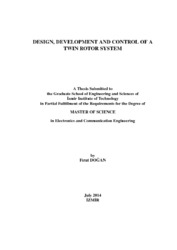Please use this identifier to cite or link to this item:
https://hdl.handle.net/11147/4204Full metadata record
| DC Field | Value | Language |
|---|---|---|
| dc.contributor.advisor | Tatlicioğlu, Enver | |
| dc.contributor.author | Doğan, Fırat | - |
| dc.date.accessioned | 2014-11-20T09:53:17Z | |
| dc.date.available | 2014-11-20T09:53:17Z | |
| dc.date.issued | 2014 | |
| dc.identifier.uri | http://hdl.handle.net/11147/4204 | |
| dc.description | Thesis (Master)--Izmir Institute of Technology, Electronics and Communication Engineering, Izmir, 2014 | en_US |
| dc.description | Includes bibliographical references (leaves: 81-86) | en_US |
| dc.description | Text in English; Abstract: Turkish and English | en_US |
| dc.description | xiii, 52 leaves | en_US |
| dc.description.abstract | Twin rotor multi-input multi-output system (TRMS) is a laboratory setup resembling the dynamics of a helicopter. It is a complicated nonlinear system with high coupling effects between the propellers. In the literature, there is no commonly agreed dynamic model for these systems mainly due to the difficulties in modelling aerodynamic effects. As a result, numerical simulations of controllers performed on currently available dynamic models do not agree with experimental results obtained from a real system. The main motivations behind this thesis are to develop a TRMS in our laboratory and then apply different control algorithms on it. Firstly, the mechanical system is described briefly. The mechanical components are explained and the computer aided design model is given. The electronic system is then presented in detail. In the electronic system, hardware parts of the TRMS (mainboard, encoder reader circuits, and motor controller circuits) and the embedded algorithms are developed. The development of the user interface that is used both to observe the TRMS and to communicate with it, is then explained. Development of a mathematical model of the TRMS is described where its physical parameters are given. Finally, the performance of the TRMS is verified by conducting experiments for proportional, integral and derivative type controllers. The analysis of the experiments are discussed and compared in average maximum steady-state error, average root-mean-square error, error standard deviation, average root-mean-square control input and control input standard deviation. | en_US |
| dc.language.iso | en | en_US |
| dc.publisher | Izmir Institute of Technology | en_US |
| dc.rights | info:eu-repo/semantics/openAccess | en_US |
| dc.subject | Twin rotor system | en_US |
| dc.subject | Embedded systems | en_US |
| dc.subject | Interface design | en_US |
| dc.subject.lcsh | Control systems | en_US |
| dc.subject.lcsh | control theory | en_US |
| dc.subject.lcsh | Helicopters--Control systems | en_US |
| dc.title | Design, development and control of a twin rotor systems | en_US |
| dc.title.alternative | Çift rotorlu sistemin tasarımı, geliştirilmesi ve denetlenmesi | en_US |
| dc.type | Master Thesis | en_US |
| dc.institutionauthor | Doğan, Fırat | - |
| dc.department | Thesis (Master)--İzmir Institute of Technology, Electrical and Electronics Engineering | en_US |
| dc.relation.publicationcategory | Tez | en_US |
| item.languageiso639-1 | en | - |
| item.fulltext | With Fulltext | - |
| item.openairecristype | http://purl.org/coar/resource_type/c_18cf | - |
| item.openairetype | Master Thesis | - |
| item.grantfulltext | open | - |
| item.cerifentitytype | Publications | - |
| Appears in Collections: | Master Degree / Yüksek Lisans Tezleri | |
Files in This Item:
| File | Description | Size | Format | |
|---|---|---|---|---|
| 10013859.pdf | MasterThesis | 1.49 MB | Adobe PDF |  View/Open |
CORE Recommender
Page view(s)
82
checked on Jul 22, 2024
Download(s)
108
checked on Jul 22, 2024
Google ScholarTM
Check
Items in GCRIS Repository are protected by copyright, with all rights reserved, unless otherwise indicated.